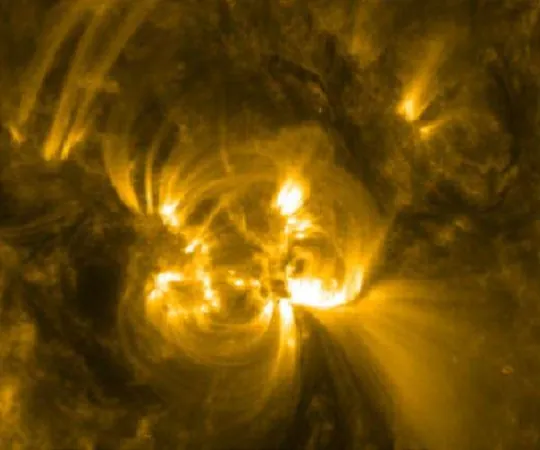
Leap in Solar Flare Predictions: Scientists Uncover Warning Signs in Coronal Loops
2025-01-17
Author: Wei Ling
Introduction
In an impressive breakthrough, scientists utilizing NASA's Solar Dynamics Observatory have identified a new potential method for predicting solar flares—one of the Sun's most powerful phenomena that pose risks not only to space expeditions but also to technology on Earth. This critical discovery comes as researchers have long endeavored to establish reliable forecasting models for these intense bursts of radiation that can disrupt satellite operations, radio communications, and even power grids.
Study Focused on Coronal Loops
Led by heliophysicist Emily Mason from Predictive Sciences Inc. in San Diego, California, the research team has focused on studying coronal loops, which are arch-like structures formed in the solar corona—the outer layer of the Sun's atmosphere. These coronal loops, which arise from magnetically active regions, have been shown to display significant fluctuations shortly before a solar flare occurs.
Findings on Brightness Variations
Their study examined the brightness variations in extreme ultraviolet light emitted by coronal loops surrounding 50 powerful solar flares. Surprisingly, the team found that the brightness of coronal loops over these eruptive regions fluctuated more drastically in the hours leading up to a flare when compared to those positioned above non-flaring areas. “We found that some of the extreme ultraviolet light above active regions flickers erratically for a few hours before a solar flare,” Mason explained, emphasizing the potential for these findings to enhance our capabilities to predict hazardous solar events.
Publication and Presentation
This research was recently published in the Astrophysical Journal Letters and presented during the 245th meeting of the American Astronomical Society. Remarkably, their results suggest that the flickering of coronal loops intensifies before stronger flares, indicating that further investigations could reinforce this correlation.
Comparison with Previous Methods
Previous methods of flare prediction often relied on examining solar magnetic fields or analyzing other coronal features. However, Mason and her team argue that focusing on the brightness variations in coronal loops could lead to more accurate warnings, potentially offering alerts 2 to 6 hours in advance with an impressive accuracy rate of 60 to 80 percent.
Expert Insights
“A lot of the predictive schemes developed so far are still based on the likelihood of flares occurring over time but don’t pinpoint their exact timing,” noted Seth Garland, a member of the research team from the Air Force Institute of Technology. Fellow team member Kara Kniezewski added, “Each solar flare is as unique as a snowflake. Our approach of tracking chaotic behavior within coronal light emissions provides a consistent metric that could be crucial for future predictions.”
Implications for Safety
The implications of this research extend beyond mere curiosity; it could significantly improve the safety of astronauts, spacecraft, electrical grids, and various technological infrastructures from the robust radiation associated with solar flares. The team envisions a future where real-time monitoring systems analyze coronal loop brightness changes and promptly issue warnings.
Future Directions
Vadim Uritsky, co-author of the study, suggests that by building on previous research predictions, scientists could refine their approach to create a more straightforward warning system ready for operational use. This promising development could usher in a new era of solar monitoring, offering protection against the unpredictable behavior of our closest star.
Conclusion
As humanity continues to explore the cosmos, understanding and predicting solar activity remains vital in safeguarding not only astronauts but also the technological framework that supports our daily lives on Earth.


 Brasil (PT)
Brasil (PT)
 Canada (EN)
Canada (EN)
 Chile (ES)
Chile (ES)
 Česko (CS)
Česko (CS)
 대한민국 (KO)
대한민국 (KO)
 España (ES)
España (ES)
 France (FR)
France (FR)
 Hong Kong (EN)
Hong Kong (EN)
 Italia (IT)
Italia (IT)
 日本 (JA)
日本 (JA)
 Magyarország (HU)
Magyarország (HU)
 Norge (NO)
Norge (NO)
 Polska (PL)
Polska (PL)
 Schweiz (DE)
Schweiz (DE)
 Singapore (EN)
Singapore (EN)
 Sverige (SV)
Sverige (SV)
 Suomi (FI)
Suomi (FI)
 Türkiye (TR)
Türkiye (TR)
 الإمارات العربية المتحدة (AR)
الإمارات العربية المتحدة (AR)